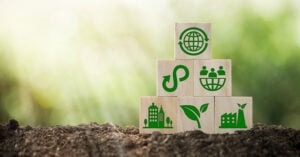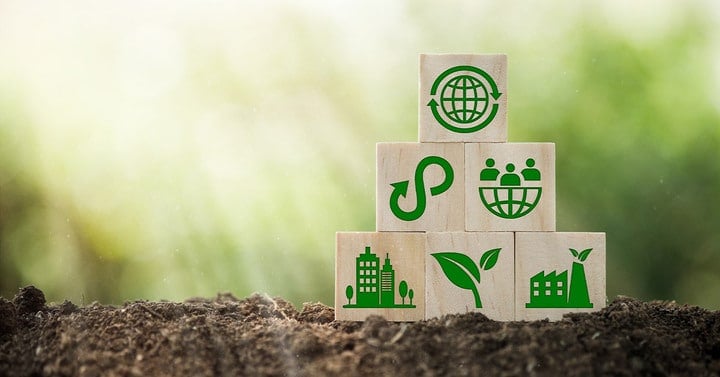What is Green Supply Chain Management (GSCM)?
To begin with, what do we mean when we say supply chain management? In the most basic sense, a supply chain refers to a logistics system in which we look at all the individual steps involved in the creation of a product, up until the point when it is finally sold. Therefore, when we begin to discuss green supply chain management (GSCM), the philosophy of it all is really quite simple. According to GEP, a global leader in AI-powered procurement and supply chain transformation, “Green supply chain management (GSCM) involves sustainable environmental processes built into conventional supply chains — from manufacturing to operations to end-of-life management — incorporating the principle of 4R1D (reduce, reuse, recycle, reclaim and degradable).”
It is easy to think that making greener changes to a supply chain can lead to more complications in terms of higher costs, but this train of thinking cannot be farther from the truth. The fact of the matter is that we live in a world that needs to change. Businesses need to implement more sustainable practices in order to gain a competitive edge, since this is exactly what customers are looking for. People want to support businesses that aim to become more environmentally conscious, and this is particularly true in the world of logistics. We all know that the logistics industry has a major carbon footprint, and it is for this reason that green supply chain management is even more important. Ultimately, the goal is to always try and minimize environmental impact, but at the same time, continue to maintain a high level of efficiency and competitiveness.

Core Components of GSCM
In truth, there are multiple key elements which serve as pillars when it comes to making green supply chain management a reality, and they all play a vital role in binding sustainability and logistics operations together.
Energy Efficiency
Energy-saving measures can be implemented both in the warehouse and throughout the transportation process. This can be achieved through the use of solar panels, or even by installing lighting like LED lights (which are known to be quite energy-efficient). Moreover, it is also a great idea to use electric or hybrid vehicles, as they generally have a lower fuel consumption rate.
Product Lifecycle
This concept is quite self-explanatory since it deals with the lifecycle of product from the point it is still an abstract idea to the point where the physical product gets sold in the market. It is always crucial to make sure that products are made with sustainability in mind. For example, is it recyclable? Does it break easily? Will someone use it once and then throw it away? When we ask ourselves questions such as these, it makes it much easier to determine how to minimize the environmental degradation that may take place at different stages of the product lifecycle.
Using Materials from Eco-Friendly Sources
It goes without saying that the first step towards a green supply chain always starts with the raw materials themselves. If there is ever a chance to choose materials from more eco-friendly sources, as opposed to resources from companies which have a notorious reputation in environmental degradation, then it is always the better choice to procure all materials elsewhere.
However, there are cases in which suppliers might not have much of a say in the raw materials they provide. According to Harvard Business Review, “Lower-tier suppliers are also the least equipped to handle sustainability requirements. They often do not have sustainability expertise or resources, and they may be unaware of accepted social and environmental practices and regulations.” It is also further emphasized that these suppliers might sometimes operate in places where the laws and regulations involving this sort of thing are quite lax, and at times, not enforced at all. This is another issue which must come to mind when considering the sources of raw materials that will be used in production.
Waste Reduction
The amount of waste can be reduced through a number of different ways. For instance, packaging waste can be minimized by choosing materials which can recycled and reused. In addition, biodegradable materials can also be used for this purpose. In many ways, this can go hand-in-hand with product lifecycle management.
Current Trends and Real Examples
In an article by Industry Week, a strong emphasis was placed on the importance of energy efficiency when it comes to making logistics better. The article also shared some particularly interesting information about what major logistics companies in the world are doing at the moment in order to become more environmentally friendly. “ DHL Group is enlisting its subcontractors in its emission reduction activities. With a goal of reducing emissions to zero by 2050, the company has pledged to increase the carbon efficiency of its own activities and those of its transport subcontractors by 50% globally by the year 2025, as compared to the 2007 baseline.”

Furthermore, DHL provides a bunch of information about what you can do in order to better plan and manage a green supply chain. We already know that transport is already a major contributor to greenhouse gas emissions, what is one way of mitigating its harmful effects? DHL says the following: “One way to reduce its impact is by Route Optimization. By using Route Optimization tools you can reduce the time and distance to the destination, with no excess mileage, and hence lower fuel consumption – reducing both emissions and costs.” Moreover, DHL has been using electric vehicles for a while now, so that’s obviously a sustainable solution to transportation.
In addition, the company Shaklee is also leading by example. Shaklee is an American natural nutrition products company, and it is well-known for being the first to receive the Climate Neutral™ certification. Furthermore, they have managed to completely offset their carbon emissions, making them a company with 0 negative impact on the natural environment. “The company’s supply chain involves franchised Shaklee businesses and distributors who have to agree to follow environmental standards and to date the company has paid more than $6 billion in commissions to its distributors.”
In Conclusion
Ultimately, it is very important for businesses to begin to do their part in order to become more sustainable. A green supply chain is a great way to start. So, we here at Saloodo! beseech you. The next time you consider the way your business is run, take a few moments to think about the whole process of where your products and raw materials are coming from, up until the point where the product lands in the hands of the consumer. Are you really being as efficient as you can possibly be? Are you doing the utmost to ensure that sustainable practices are maintained? We must all do what we can, especially logistics companies, in order to make some kind of significant difference. In the end of the day, I think we can all agree that we will always want to protect this vibrant blue planet we call home.









